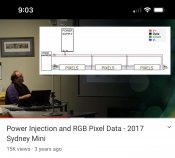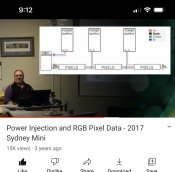BrianZ
Full time elf
- Thread starter
- #16
I understand and thank you.A bit difficult to answer without knowing more about the physical layout of your display. Yes and no. Yes you can inject at the end of a string from a 15 Amp fuse block but you need to add amperage protection (sub-fusing) to insure the string does not burn. So yes while the amperage for the entire string will or can be increased, no because anywhere within the string amperage needs limited to approximately 5 Amp or less. A question is, where is the 15 Amp fuse? Rather obvious I think that a 15 Amp fuse immediately prior to an injection point is not beneficial.
An example may help. I have a 350 pixel prop about 40 feet from the controller and supply. The electronics are in a garage. The prop has a single power injection cable fused at 15 Amp near the supply. The controller to the prop is a smaller 22 AWG 2 conductor V- and data (no V+). I sometimes like to wake the neighborhood so I designed it for 80% White which calculates to about 16 Amp. To equalize the string voltage drop I inject at the beginning, middle (about pixel 150), and the end. If something happens the string could consume all 15 amp in a localized area and burn the string. To prevent that I sub-fuse, that is each injection point has it own 5 Amp weatherproof fuse. I could have ran 3 power injection cables but that is more cable management; not sure but I think a single larger AWG was a bit more economical as well.



